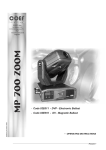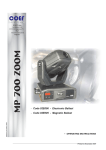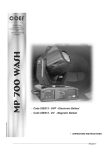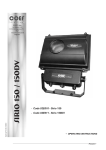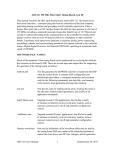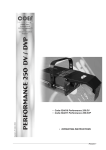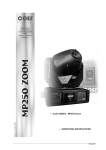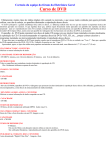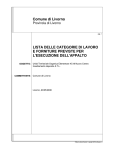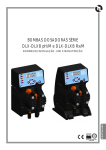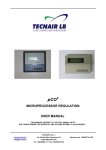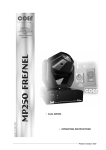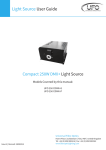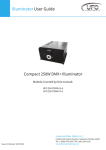Download COEF MP700 Zoom
Transcript
Http://www.coef.it E-mail:[email protected] Code ZL-012101-01-DVP-Electronic Ballast Code ZL-012201-01-DV-Magnetic Ballast Printed in Aug 2005 Http://www.coef.it - E-mail: [email protected] This manual has been organized in order support the user, the installer or the maintenance operator of the described unit with those necessary informations for a correct use of the installation and working procedures of the same unit.The various procedures will be just signalled by indicators (when necessary) evidencing the operation dangers and the necessity of technical support. Please find here below a list of symbols and relative meaning: OPERATOR : Not particulary qualified staff, that can operate when no specific knowledge is required COEF OPERATOR: Technical staff, qualified and trained by the constructor, for repair and extraordinary operations. MECHANICAL OPERATORS: Staff employed in the ordinary mechanical maintenance. SPECIALIZED MECHANICAL OPERATOR: Qualified staff employed in extraordinary authorized installations and repair. ELECTRIC OPERATORS: Staff employed in the ordinary electric maintenance. SPECIALIZED ELECTRIC OPERATORS: Qualified staff employed in extraordinary authorized installations and repairs. DANGER SIGNAL: Generic dager signal and electric shock danger signal. GENERAL WARRANTY CONDITIONS • • • • • • • • The guarantee is valid for a period of 12 months from the date of purchase of the equipment. The guarantee is not valid in case a wrong voltage or frequency is selected. The parts which are proved to have manufacturing defects are also covered by the guarantee. The external parts of the equipment, its removable elements and lamps are excluded from the guarantee; for these parts we recommend to follow the directions supplied by their manufacturers. The guarantee is not valid in case of tampering or repairs carried out by non-authorized personnel. The replacement of the equipment during the validity of the guarantee is not provided for. The transport freights from and to the manufacturer for repairs under guarantee are at Customer’s charge. When applying for the repair, always mention the serial number and the model of the equipment. PACKING CONTENTS Carefully check the contents of the packaging and the completeness of the components. If any of the parts listed hereunder is missing, please contact your Dealer immediately: • • • • • • • MP700 Zoom complet unit. This user manual. 2 quick lock/release (omega) brackets. 1 connector XLR 3 pin male. 1 connector XLR 3 pin female. 1 connector POWER. 1 safety-chain equipped with two snaps. PROTECT NATURE. DO NOT DISPOSE OF THE PACKAGING IN THE ENVIRONMENT. CAREFULLY KEEP THE BOX AND THE COMPONENTS OF THE PACKAGING FOR ANY DISPLACEMENT OR RE-SHIPMENT OF THE EQUIPMENT. Do not leave the packaging elements (polystyrene, nylon, metal parts, etc.) unattended; they might be dangerous for children. http://www.coef.it - [email protected] Pag. 3 MP700 ZOOM DV with Magnetic Ballast MP700 ZOOM DVP with Electronic Ballast Code: ZL-012201-01 Code: ZL-012101-01 3.0 INSTALLATION The constructor is not be considered responsible in case of: • • • • • • • • • Improper use of the unit or use by not trained staff Use in contrast with the directions on work safety Wrong installation Defective power supply Serious lacks in the necessary maintenance Unauthorized modifications and interventions Use of spare parts that are not original or not specific for the unit Total or partial inobservance of instructions Unusual events 3.1 LAMP MOUNTING OR REPLACING WARNING: read carefully • • • • • • • • Switch off the projector before operating. The lamp used in the fixture is a high pressure lamp and must be handled very carefully. The unit is realized to use only MSR700 lamp; absolutely don’t use other types of lamp. The lamp must be changed if damaged or deformed by heat. Wait at least 15 minutes after the projector has been switched off before operating again, in order to let it cool down and avoid the lamp explosion. Wear protection gloves and glasses. Read carefully the lamp builder’s instructions. Don’t look directly the lamp. Wait 30 minutes in order to avoid burns. Unscrew with a cross screwdriver the first screw A for a single turn; unscrew the second one completely B; unscrew completely the screw A and to remove the cover that supports the lampholder. Insert delicately the lamp in the projector support, driving it with the round cover. Pay attention: the lampholder’s wires must correctly reenter in the projector. Block the cover screwing the screws up ( part. A-B). http://www.coef.it - [email protected] Pag. 5 3.2 OPERATING VOLTAGE WARNING : unplug the fixture from the power supply before operating . The operation must be performed only by highly specialized staff. WARNING : The wrong selections of the operating tension and/or frequency compromise the good operation of the fixture and will immediately invalid the COEF warranty. 3.3 Settings for magnetic ballast Code:ZL-012201-01 Cod. 02E010 The fixture can work at the following tensions : 230 V~50 / 60 Hz and 208 V~ 60 Hz (optional). Please be careful to connect the cable to the right terminal that is relevant to the desired tension and frequency; both on the ballast and on the transformer located in the MP700Zoom base. Please carefully follow the indications shown in the pictures A and B. B A 3.4 Settings for electronic ballast Code:ZL-012101-01 Cod. 02E011 The fixture can work at the following tensions : 100V ~ 60 Hz, 120V ~ 60 Hz, 208 V ~50/ 60 Hz, 230 V ~50 / 60 Hz, 250 V ~50 / 60 Hz. You can modify the settings following the needs of the country were the fixture is installed. This operation is easily done by moving the cable to the right terminal of the electronic board transformer that is located in the base of the fixture. The ballast (electronic) does not need any adjustment. We recommend you to update the serigraphy table at the new value. 3.5 PROJECTOR INSTALLATION To fix the MP700 Zoom is necessary, when the installation has to be on a raised-from-the ground support, to block the quick lock/release brackets of the unit by means of a screw provided with nut and locknut measuring not less than M10X50, to insert in the central pre-arranged hole on the fixing bracket. In addiction to the provided quick lock/release (omega) brackets, in order to guarantee a necessary security and in respect of the actual safety rules concerning the projectors’ installation, it is compulsory to install a safety-chain, equipped with two snaps, provided with the projector, to connect the MP700 Zoom‘s body to the fixing structure. ATTENTION: the safety chain, equipped with two snaps which can be hooked to the two pivots placed under the base of the MP700 Zoom, (see part. A), must be properly installed and fixed to the supporting structure, in a way that an incidental givin in of the main bracket would leed to the shortest possible fall of the projector. After such an intervention the safetychain must be replaced with another original part. ATTENTION: COEF is not responsible for installations not correctly made or made without respecting the above indications: those installations are considered dangerous. Pag. 6 http://www.coef.it - [email protected] 4.0 POWER SUPPLY CONNECTIONS WARNING: In order to guarantee the utmost safety, connect the apparatus only to a properly earthed mains system. The projector is designed to work at the tension and frequency indicated by the electrical data label on the rear. Before connecting the projector to the mains, a qualified electrician must check its conformity. • The projector must be protect by an adeguated magneto-thermal switch . • Don't power the unit with a dimmer circuit. Power : indicated in the the serigraphy table (tollerance: +5% / -10%) Should there be different electrical characteristics or special steps to be carried out, please contact COEF by telephone or e-mail. Supply the projector by connecting it as indicated in picture. 4.1 DMX 512 CONNECTIONS Connect the projector and the control unit to a wire in conformity with the EIA RS-485 standards: braided bipolar, shielded, 120 ohm of characteristic impedance, 22-24 AWG, equipped with Cannon 3 Pin XRL plugs. Respect the DMX 512 signal input and output according to the panel indications. A terminal pin with 120 ohm resistance (¼ Watt minimum) must be inserted between the terminals 2 and 3 in the last piece of apparatus. http://www.coef.it - [email protected] Pag. 7 5.0 SPECIAL FUNCTIONS AND PROJECTOR ASSIGNMENT On the front panel of MP700 Zoom you'll find a section for the additional functions and for setting the projector. Following the picture, you can see all the offered possibilities in detail. All operations are to be carried out with the E, F, G, H buttons, respectively indicated as MENU, ENTER, DOWN and UP. The display D will inform you about the selected functions. The 3 A, B, and C leds will allow you to know: A = reception of the DMX line. B = lamp ON. C = errors indicated on the ERR table (see table 6.0). On switching the projector on, the display will indicate the type of projector and the version of control software which have been installed. To this purpose, please remember that this type of projector belongs to a new generation of projectors, designed with the possibility of updating the software version through the normal DMX connection by means of a programmer deliberately created: UNI-PROG 8. After the indication MSTR HOME, the projector carries out the RESET and gets ready to be controlled from the connected console. The display will indicate 1 as default value. This means that the first channel occupied by the projector will respond to the values sent to channel 1 by the DMX line. This enables us to make MP700 Zoom (which we are installing) completely independent from control or integral with any other installed projector. General Rules: Refer to the Table of Section 6.0 in the following page. By each pressure, Button MENU (E) permits to go backwards by one level. G and H (DOWN and UP) buttons select functions and sub-functions. Button F (ENTER) enters the function and confirms a control. By pressing Button MENU (E) and buttons UP and DOWN (H and G) you can select the menu you have to modify. Once the wished menu is reached, press Button F (ENTER) to confirm your selection and enter the function. Press G or H to enter the sub-functions if available. Always confirm your selection with ENTER. Press MENU to go out of the function and press again to go back to the starting level. Example: We installed our projector on the ceiling and for this reason we want the visualization of the display to be correct. Press MENU Press H (UP) 11 times up to “MISC” Press ENTER the Display will show “RSET” Press H (UP) twice up to “DSPL” Press ENTER the Display will show “ONOF” Press H (UP) once up to “STRV” Press ENTER the Display will show “STND”; this is the actual configuration state. Press H (UP) once up to R.E.V..; the blinking point indicate the available configuration. Press ENTER ...... The Display visualization as been rotated to 180°. Press MENU 4 times to return to starting MENU. The indication of the display will automatically come back after 120 sec. and inform on the set starting channel DMX. If we are now in a sub-function, this automatic device will not assume control. Pag. 8 http://www.coef.it - [email protected] 6.0 MENU, FUNCTION & SUB-FUNCTIONS MENU FUNCTION DMX 1/497 LAMP TIME MACH SUB-FUNCTION (*) = default value - factory assigned DESCRIPTION DMX start channel Lamp working hours (KH=thousands H=hours) Lamp working hours reset (confirm by ENTER) Projector working hours (KH=thousands H=hours) SHOW - KH, H RST - GO? SHOW - KH, H ERR E OK E110 E220 E230 E240 E250 E260 E420 E510 E520 W310 W410 W422 W424 No error EEPROM failure Malfunction of the COLOR motor/sensor Malfunction of the GOBOS motor/sensor Malfunction of the GOBOS ROT. motor/sensor Malfunction of the PAN motor/sensor Malfunction of the TILT motor/sensor No ignition of the lamp beyond 3 attempts. (break?) Malfunction encoder PAN Malfunction encoder TILT Checksum Setup not valid Lamp working hours for more than 500 hours LAMP start beyond 1 attempts (attempt to warmth or exausted lamp) LAMP off in not standard mode SHUT HOME TEST ADJ SET HOME SHUTTER TEST SHUTTER Fine regulation of the closing shutter. Reserved COL HOME TEST CSHUT MODE ADJ P1 (*) OFF / ON (*) MOD1 / MOD2 P 1 / P20 - 49 / 49 -29 / 29 HOME COLOR TEST COLOR Color change in black-out position Color switching or linear wheel motion Fine regulation of the COLOR position (P1 / P20) -29 / 29 HOME GOBOS TEST GOBOS GOBO change in black-out position Fine regulation of the NEUTRAL GOBO position GOBO HOME TEST GSHUT ADJ RGOB HOME TEST HOME Rotation GOBOS TEST Rotation GOBOS CONV HOME TEST ADJ HOME Conversion filters TEST Conversion filters Fine regulation of the CONVERSION FILTER position (*) OFF / ON P1 P1 -99 / 99 FCUS HOME TEST HOME Focus trolley TEST Focus trolley ZOOM HOME TEST HOME ZOOM trolley TEST ZOOM trolley EFCT HOME TEST ADJ HOME Prism/Frost TEST Prism/Frost Fine regulation of the PRISM position RPRS TEST TEST of the Prism rotation IRIS HOME TEST HOME Iris TEST Iris PAN HOME TEST STRV ENCO (*) STND / REV (*) ON / OFF HOME PAN movement TEST PAN movement Switch movement direction ( DX / SX) ON/OFF the automatic repositioning of the PAN TILT HOME TEST STRV ENCO (*) STND / REV (*) ON / OFF HOME TILT movement TEST TILT movement Switch movement direction (UP / DOWN) ON/OFF the automatic repositioning of the TILT SCH CH1 / CH16 LAMP ONOF CDMX RSET RDMX DSPL MISC SWPT EDIM VER P1 -99 / 35 DMX value for the indicated channel (*) ON / OFF/ AUTO (*) NO / YES Lamp ON / Lamp OFF / LAMP OFF after 1 hour of no change on DMX LAMP switching on by DMX control (*) YES / NO (*) ON / OFF (*) STND / REV (*) STND / SWAP YES / NO (automatic value) MASTER HOME (Starting RESET) MASTER HOME via DMX control Display on / Display off 180° rotation of the visualization display Channel control switch PAN / TILT If YES = Electronic Dimmer ON (Electronic Ballast) Show the installed software version http://www.coef.it - [email protected] Pag. 9 7.0 CHANNELS AND DIGITAL VALUES CH 1 2 MODE1 2 MODE2 SHUTTER / STROBE / DIMMER 0-5 SHUTTER closed 6-100 DIMMER from channel 14 value 101-110 DIMMER 0 > 100% Automatic 6 sec. 111-120 DIMMER 100% > 0 Automatic 6 sec. 121-126 DIMMER 0 > 100% slow Faster shut down 127-132 DIMMER 0 > 100% middle Faster shut down 133-138 DIMMER 0 > 100% fast Faster shut down 139-144 DIMMER 100% > 0 slow Faster open 145-150 DIMMER 100% > 0 middle Faster open 151-156 157-162 163-168 169-174 175-180 181-186 187-192 193-250 251-255 DIMMER 100% > 0 fast DIMMER 0 > 100% > 0 slow DIMMER 0 > 100% > 0 middle DIMMER 0 > 100% > 0 fast Strobe lamp from 1 to 6 random Strobe lamp from 1 to 6 random Strobe lamp from 1 to 6 random STROBE Speed adjustment SHUTTER open COLOR MODE 1 0-5 Neutral 6 - 15 Yellow 16 - 25 Blue 26 - 35 Magenta 36 - 45 Green light 46 - 55 Orange 56 - 65 Cyano 66 - 75 Pink 76 - 85 Red 86 - 95 Blu light 96 - 105 Green 106 - 115 Wood 116 - 125 126 - 135 136 - 145 146 - 155 156 - 165 166 - 175 176 - 185 186 - 195 196 - 200 201 - 205 206 - 230 231 - 255 White-Yellow Yellow-Blue Blue-Magenta Green light-Orange Orange-Cyano Cyano-Pink Red-Blue light Blue light-Green Random full-color (slow) Random full-color (fast) CW Rotation adjustment CCW Rotation adjustment COLOR MODE 2 0-5 6 - 10 11 - 15 16 - 20 21 - 25 26 - 30 31 - 35 36 - 40 41 - 45 46 - 50 51 - 55 56 - 60 61 - 180 181 - 185 186 - 190 191 - 195 196 - 200 201 - 215 216 - 235 236 - 255 Green Wood Positioning Random fast Random middle Random slow Random very slow Random very fast CW Rotation adjustment CCW Rotation adjustment 111 - 120 121 - 130 131 - 140 141 - 150 151 - 160 161 - 170 171 - 180 181 - 190 191 - 198 199 - 205 206 - 230 231 - 255 GOBO 2 chann.4 controls position GOBO 3 chann.4 controls position GOBO 4 chann.4 controls position GOBO 5 chann.4 controls position GOBO 6 chann.4 controls position GOBO 7 chann.4 controls position GOBO 8 chann.4 controls position GOBO 9 chann.4 controls position GOBOS Random fast GOBOS Random slow CW Rotation adjustment CWW Rotation adjustment Neutral Yellow Blue Magenta Green light Orange Cyano Pink Red Blu light 3 GOBOS 0 - 10 Neutral 1 1- 20 GOBO 1 21 - 30 GOBO 2 31 - 40 GOBO 3 41 - 50 GOBO 4 51 - 60 GOBO 5 61 - 70 GOBO 6 71 - 80 GOBO 7 81 - 90 GOBO 8 91 - 100 GOBO 9 101 - 110 GOBO 1 4 ROTATION GOBOS 0-5 STOP 6 - 255 From 0 to 540° GOBO positioning 6 - 130 CW Rotation adjustment of the GOBO 131 - 255 CWW Rotation adjustment of the GOBO 5 6 7 8 chann.4 chann.4 chann.4 chann.4 chann.4 chann.4 chann.4 chann.4 chann.4 chann.4 controls rotation controls rotation controls rotation controls rotation controls rotation controls rotation controls rotation controls rotation controls rotation controls position PAN MOVEMENT PAN MOVEMENT FINE ADJUSTMENT TILT MOVEMENT TILT MOVEMENT FINE ADJUSTMENT 9 COLOR FILTER CONVERSION 0 - 79 Neutral 80 - 169 Conversion 3400°K 170 - 255 Conversion 5600°K 10 FOCUS ADJUSTMENT 0 - 255 Linear FOCUS adjustment 11 LINEAR ZOOM ADJUSTEMT 0 - 255 Linear ZOOM adjustment Pag. 10 http://www.coef.it - [email protected] Faster open [reg. 0.0-0.5 sec.] [reg. 0.6-1.5 sec.] [reg. 1.6-2.5 sec.] CH 12 EFFECTS (Frost - Prism) 0-5 Neutral 6 - 20 Automatic FROST from 0 to 100% (velocity adjustment) 21 - 40 Automatic FROST from 100% to 0 (velocity adjustment) 41 - 60 Frost 61 - 80 Prism 3 faceted 81 - 170 CW PRISM rotation with velocity adjustment 171 - 255 CWW PRISM rotation with velocity adjustment 13 IRIS 0-5 6 - 130 131 - 150 151 - 170 171 - 190 191 - 210 211 - 230 231 - 250 251 - 255 Open / Neutral IRIS with manual regolation (100% - 0) IRIS closed IRIS 0 - 100% IRIS 100% - 0 IRIS 0-100%-0 slow IRIS 0-100%-0 middle IRIS 0-100%-0 fast IRIS 0-100%-0 random DIMMER 0-5 6 - 250 251 - 255 DIMMER Closed DIMMER regolation DIMMER Open 14 WARNING: position CHANNEL 1 at a value between 6 and 250, in order to control DIMMER with this channel. 15 16 USE MODE (only Electronic Ballast code 02E011) 0-5 Studio mode 6 - 250 Regolation 251 - 255 Live mode MOVEMENTS TIME ADJUSTMENT (work on channels 5-7) 0-5 NO delay 6 - 250 adjustment delay 251 - 255 MAX delay 7.1 SPECIAL ACTION When the lamp control via DMX (CDMX) and the reset via DMX (RDMX) function have been activated in the configuration menu, it’s possible, by a combination of the channels values, to control the lamp switch ON/OFF or to allow the projector MASTER RESET. Lamp ON via DMX: CHANNEL 2 = value 0 CHANNEL 3 and CHANNEL 4 = value 0 > 255 > 0 Lamp OFF via DMX: CHANNEL 2 = value 255 CHANNEL 3 and CHANNEL 4 = value 0 > 255 > 0 MASTER RESET: CHANNEL 1 = value 0 CHANNEL 2 and CHANNEL 3 = value 0 > 255 > 0 http://www.coef.it - [email protected] Pag. 11 8.0 LAMP ADJUSTMENT • Don’t look directly the beam trough the lens. • The lamp is pre-regulated by the factory. Only fine-adjustment. Don’t move the screws ”C” up to upper or lower extremities. Lamp adjustment is necessary to obtain a uniform and powerful light beam. Switch on the projector and set the channels without gobo and colors. Adjust the three screws C until you reach the ideal condition between power and homogeneity. 9.0 GOBOS REPLACEMENT WARNING: switch off the projector before operating Open the cover of MP700 Zoom by the 4 fast screw. The gobo-wheel of the MP 700 Zoom contains dichroic gobos. They are interchangeable simply by removing the little elastic ring with a screwdriver (see figure). In order to replace a dichroic gobo with a steel gobo, put a thick ring between the gobo and the elastic ring. Insert the chosen gobo and place again the steel ring, paying attention that it reaches its correct position. Pag. 12 http://www.coef.it - [email protected] 10.0 ORDINARY MAINTENANCE Ordinary maintenance on the projectors MP 700 Zoom is necessary to maintain the perfect efficiency of the unit and to avoid defects like the low luminosity of the light beam or the elevated overheating of the equipment. In the figures you can see those components that can easily accumulate dust and grease. Clean them using a soft cloth and common glass-cleaners. 10.1 EXTRAORDINARY MAINTENANCE WARNING: switch off the projector before operating To make an extraordinary maintenance, it is necessary the presence of a generic or qualified mechanical operator, according to the type of the needed intervention. In order to make its use easier, we advise you to completely draw out the mechanic unit of the zoom and focus movements as follows: disconnect the two motors (connectors B and C) and the fan (connector D); remove the 4 screws (part. A) and carefully extract the whole mechanic unit. Clean carefully the indicated parts. Once the frame with the Zoom/Focus mechanic unit has been removed, it is possible to clean the parts which are usually difficult to reach. Reassemble the Zoom/Focus unit carefully, being sure in particular that the blade with prism and frost is positioned between the two lenses of the Zoom/Focus unit. Remember then to connect again the 2 motors and the fan to their connectors. http://www.coef.it - [email protected] Pag. 13 You must particularly take care of the sensors which are really fundamental in the unit working. The sensors are absolutely necessary when a general reset of the projector is needed. If this function is not correctly executed, it will totally compromise the regular working of the projector, at least for the group referred to the sensor itself. The sensors of the encoders concerning the PAN and TILT movements are located in the base and in the arm of the MP700 Zoom respectively. The pictures clearly show how you can reach these components and where you can correctly operate for their maintenance. Another place where grease and dust settle is inside the lamp-box. Carry out the following operations in order to clean: unscrew, but not completely, the 4 screws on the side of the fin unit located on top of the bulb; draw out the full fin unit; clean the antiheat filter and the parabola of the bulb; assemble the fin unit again by inserting first the part next to the lamp-board and then the 4 screws in their seat; tighten carefully. Pag. 14 http://www.coef.it - [email protected] 10.2 ELETTRONIC MAINTENANCE WARNING: switch off the projector before operating This section is dedicated in detail to the electronic connections between the card and the mechanical components, assembled in the projector. These informations will be absolutely necessary when the mechanical unit has to be removed from the projector for maintenance and/or repair. The connections are made using handy connectors and are detailed in figure where you can find indications about the connection between a specific connector and a specific component of the mechanical unit. This includes the motors and the sensors of the various effects wheels ( color, gobos, prisms, shutter etc.). WARNING! An improper use of this documentation made by not specifically qualified staff can damage irremediably the electronic and/or mechanical components of the projector. 1 Motor SHUTTER / STROBE 15 Sensor PAN 2 Motor COLORE wheel 16 Sensor TILT 3 Motor GOBOS wheel 17 S1 Sensor COLOR wheel 4 Motor GOBOS Rotation 18 S2 Sensor GOBOS wheel 5 Motor EFFECTS wheel 19 S3 Sensor GOBOS Rotation 6 Motor ZOOM 20 ON/OFF Lamp (only Magnetic Ballast version) 7 Motor FOCUS 21 Electronic Ballast connector 8 Motor CONVERSION FILTERS 22 LIGHT Sensor / NTC Sensor 9 Motor IRIS 23 POWER Connector 10 Motor PRISM Rotation 24 Faston GROUND connection 11 Motor TILT 25 DMX IN/OUT 12 Motor PAN 26 Head FAN 13 Encoder TILT 27 Base FAN 14 Encoder PAN 23 - Power connector on board 1-2 12V~ +/- 5% 3-4 27V~ +/- 5% 5-6 27V~ +/- 5% Blue Grey Black http://www.coef.it - [email protected] Pag. 15 11.0 TROUBLESHOOTING PROBLEM The projector doesn’t swich on CAUSE ACTION - The power supply is not present Check if the luminous indicator is lighted or not. - The lamp is not working Replace the lamp. - The thermal switch is active Just to wait for little of time. The projector swiches on but - Wrong DMX configuration doesn’t answer to commands Defecting projection Make sure that the projector is correctly configurated. - Defective cables Replace or repair the DMX cable. - LED A is off Check the control unit & DMX cable. - Defective control unit Check the control unit by means of other working projectors. Technical aid is required. - The lens is broken Check that the lens are not broken. - Dust or grease stored on the all Remove dust or grease stored on lenses. parts of projector Projection with halo - Dust or grease stored on the all Carefully clean the optical group lenses and the projector components (see “Mainparts of projector tenance” chapter). Carefully clean the optical group lenses The color or other effects doesn’t - Position sensor dirty with dust or and the projector components (see “Maintenance”). grease coincide to the selected value. Technical aid is required. - Defective motor - Electronic board Carefully clean the optical group lenses and the projector components (see “Maintenance”). The PAN or TILT movement - Defective motor doesn’t coincide to the selcted - Electronic board value Technical aid is required. The projector does not carry out - ENCO off in the PAN/TILT confi- Set ON ENCO Function of PAN/TILT configuration menu (cap. 6.0). the automatic repositioning of the guration menu (cap. 6.0) PAN or TILT movements. Pag. 16 http://www.coef.it - [email protected] MP 700 ZOOM TECHNICAL REFERENCE Wiring diagram 12-08-2005 Cod.ZL-012 Scheda tecnica MP 700 ZOOM Schema elettrico 11.0 PROBLEMI DIFETTO Il proiettore non si accende CAUSA - Mancanza di alimentazione di rete RIMEDIO Verificare l’accensione della spia sull’interruttore di accensione. Attendere lo sblocco del termico. - Interrutore termico azionato Sostituire la lampada. - Lampada non funzionante Il proiettore si accende ma - Configurazione DMX errata non risponde ai comandi - Se il led A non si accende Assegnare il valore DMX per il proiettore. Controllare DMX (cavo, console, ecc.). Controllare l’unità di pilotaggio con altri proiettori funzionanti. - Unità di pilotaggio difettosa Sostituire i cavi o riparare. - Cavi di collegamento difettosi Intervento di assistenza tecnica. Proiezione difettosa - La lente o più lenti rotte - Strati di grasso o polvere sulle lenti Proiezione con alone Controllare lo stato delle lenti. Rimuovere la polvere e/o grasso sulle lenti. - Strati di grasso e/o polvere su tutte le Effettuare una accurata pulizia di tutte le parti del proiettore (vedi capitolo manutenparti del proiettore zione). Il colore o altri effetti non - Sensori di posizione sporchi corrispondono al valore impostato - Motore difettoso - Scheda elettronica Il movimento del PAN o del TILT non segue i valori - Motore difettoso - Scheda elettronica impostati Effettuare una accurata pulizia di tutte le parti del proiettore (vedi capitolo manutenzione). Intervento di assistenza tecnica. Intervento di assistenza tecnica. Il proiettore non esegue il - Configurazione menu PAN o TILT e Vedi tabella paragrafo 6.0 per abilitare il riposizionamento ai canali del PAN e/o del riposizionamento auto- sottofunzione ENCO a OFF TILT. matico per il movimento PAN o TILT Intervento di assistenza tecnica. Per altri problemi contattare: [email protected] [email protected] Pag. 16 http://www.coef.it - [email protected] 10.2 MANUTENZIONE ELETTRICA/ELETTRONICA ATTENZIONE: Disconnettere l’apparecchio dalla rete prima di questo intervento Questa sezione è dedicata al dettaglio dei collegamenti elettronici tra la scheda e le parti meccaniche montate all’interno del proiettore. Queste informazioni risultano indispensabili nel caso in cui le piastre meccaniche, o la stessa scheda elettronica, vengano rimosse dall’interno del proiettore per manutenzione e/o riparazione. I collegamenti effettuati attraverso comodi connettori vengono dettagliati nella figura dove è indicata la corrispondenza di un determinato connettore ad una determinata parte componente della piastra meccanica, che incorpora i motori e i sensori delle ruote dei vari effetti ( colore, gobos, otturatore ecc. ). ATTENZIONE! Un uso improprio di questa documentazione, od effettuato da personale non espressamente qualificato, può danneggiare in modo irrimediabile le parti elettroniche e/o meccaniche del proiettore su cui vengono eseguite delle operazioni di manutenzione straordinaria e/o riparazioni. Motore ruota EFFETTI 5 Motore rotazione GOBOS 4 Motore ruota GOBOS 3 Motore ruota COLORE 2 Motore OTTURATORE / STROBO 1 Motore IRIS 9 Motore filtri CONVERSIONE 8 Motore FUOCO 7 Motore ZOOM 6 Motore TILT 11 Motore rotazione PRISMA 10 Encoder PAN 14 Encoder TILT 13 Motore PAN 12 15 16 17 18 19 20 21 22 23 24 25 26 27 Sensore PAN Sensore TILT S1 S2 S3 Sensore ruota COLORE Sensore ruota GOBOS Sensore rotazione GOBOS ON/OFF Lampada (versione Ballast Magnetico) Comando Ballast Elettronico Sensore di LUCE / Sensore NTC Connettore di alimentazione Faston per cavo di Terra Ingresso DMX Attacco ventole TESTA Ventole Base 23 - Connettore ALIMENTAZIONE su scheda 1-2 12V 3-4 27V 5-6 27V +/- 5% +/- 5% +/- 5% Blu Grigio Nero http://www.coef.it - [email protected] Pag. 15 Una particolare attenzione andrà dedicata ai sensori che rivestono un ruolo fondamentale nel funzionamento dell’apparecchiatura. I sensori sono indispensabili nel momento del reset generale del proiettore, funzione che se non eseguita correttamente, pregiudica in modo totale il funzionamento regolare del proiettore stesso, almeno per quanto riguarda il gruppo associato al sensore stesso. I sensori degli encoder realativi ai movimenti PAN e TILT si trovano rispettivamente nella base e nel braccio dell’MP700 Zoom. Le immagini illustrano chiaramente come accedere a questi componenti e dove intervenire con precisione per l’intervento di manutenzione. Altro punto dove si depositano grassi e polvere è all’interno della scatola-lampada; per la pulizia procedere come segue: svitare non completamente le 4 viti a lato del blocco alette posto sopra la lampada; estrarre tutto il blocco alette; pulire il filtro anticalore e la parabola della lampada; rimontare il blocco alette inserendo prima la parte vicina al pannello-lampada e poi le 4 viti nel loro alloggio; riavvitare con cura. Pag. 14 http://www.coef.it - [email protected] 10.0 MANUTENZIONE ORDINARIA La manutenzione ordinaria sui proiettori MP700 Zoom è indispensabile per mantenere in perfetta efficenza l’apparecchiatura ed evitare l’insorgere di difetti come ad esempio la scarsa resa luminosa o l’eccessivo surriscaldarsi della parte elettronica. Nella 2 figure vengono evidenziate le parti più sottoposte ad accumulare polveri e grassi. Procedere alla loro pulizia con un panno morbido e normali prodotti per la pulizia dei vetri. 10.1 MANUTENZIONE STRAORDINARIA ATTENZIONE: Disconnettere l’apparecchio dalla rete prima di questo intervento Per eseguire una manutenzione straordinaria è richiesto l’intervento di un manutentore meccanico semplice o di uno qualificato, a seconda del tipo di intervento da eseguire. Per semplicità consigliamo di estrarre completamente la meccanica dei movimenti zoom e fuoco seguendo queste indicazioni: scollegare i due motori (connettori B e C) e la ventola (connettore D);rimuovere le 4 viti (part. A) ed estrarre con attenzione tutta la meccanica. Pulire con cautela le parti indicate. Una volta rimosso il telaio con la meccanica Zoom/Fuoco, si potrà procedere alla pulizia di tutte quelle parti altrimenti poco accessibili. Rimontare il blocco Zoom/Fuoco attentamente, in particolare osservare che la paletta con prisma e frost sia posizionata nel mezzo alle due lenti del blocco Zoom/Fuoco.Ricordarsi di ricollegare i 2 motori e la ventola ai rispettivi connettori (B, C, D). http://www.coef.it - [email protected] Pag. 13 8.0 REGOLAZIONE DELLA LAMPADA • • Non guardare mai direttamente nella lente d’uscita del fascio luminoso. La lampada è pre-regolata in fabbrica. Regolare solo finemente. Non portare le viti al punto estremo inferiore o superiore. La regolazione della lampada è indispensabile per ottenere un fascio luminoso uniforme e potente. Accendere il proiettore ed impostare i canali in modo tale da avere un fascio senza gobo e di colore bianco. Regolare le 3 viti a croce (part. C) fino a raggiungere la condizione ottimale tra potenza del fascio luminoso ed omogeneità. 9.0 SOSTITUZIONE GOBOS ATTENZIONE: Disconnettere l’apparecchio dalla rete prima di questo intervento Per prima cosa occorre aprire il coperchio dell‘MP700 Zoom per mezzo delle 4 viti ad ¼ di giro che lo bloccano al telaio. La ruota gobos dell‘MP700 Zoom contiene gobos dicroici. E’ possibile inserire anche gobos metallici. I due tipi di gobos risultano intercambiabili semplicemente rimuovendo l’anello elastico in acciaio (part. A) con l’aiuto di un piccolo cacciavite a taglio fine. Per permettere la sostituzione di un gobo dicroico con uno di acciaio, quest’ultimo deve avere un anello di spessore da inserire prima dell’anello elastico. Inserire il nuovo gobo prescelto e rimettere l’anello di acciaio (part. A) avendo cura che questo ritorni nella sua gola predisposta. Pag. 12 http://www.coef.it - [email protected] CANALE DIMMER Chiuso Regolazione DIMMER DIMMER Aperto DIMMER 0-5 6 - 250 251 - 255 Neutro Regolazione manuale IRIS (100% - 0) IRIS chiuso IRIS 0 - 100% IRIS 100% - 0 IRIS 0-100%-0 lento IRIS 0-100%-0 medio IRIS 0-100%-0 veloce IRIS 0-100%-0 random IRIS 0-5 6 - 130 131 - 150 151 - 170 171 - 190 191 - 210 211 - 230 231 - 250 251 - 255 13 EFFETTI (Frost - Prisma) 0-5 Neutro 6 - 20 Frost automatico da 0 a 100% (regolabile in velocità) 21 - 40 Frost automatico da 100% a 0 (regolabile in velocità) 41 - 60 Frost 61 - 80 Prisma a 3 facce 81 - 170 Rotazione prisma in senso orario regolabile in velocità 171 - 255 Rotazione prisma in senso antiorario regolabile in velocità 12 14 ATTENZIONE: posizionare il CANALE 1 ad un valore compreso tra 6 e 250 per controllare il DIMMER con questo canale. REGOLAZIONE TEMPI MOVIMENTI (agisce sui canali 5-7) 0-5 Nessun ritardo 6 - 250 ritardo regolabile 251 - 255 ritardo massimo 16 MODALITA’ DI FUNZIONAMENTO (solo nella versione con Ballast elettronico Codice: 02E011) 0-5 MODALITA’ DI FUNZIONAMENTO STUDIO 6 - 250 Regolazione tra ledue modalità 251 - 255 MODALITA’ FUNZIONAMENTO LIVE 15 7.1 COMANDI SPECIALI Se nel MENU configurazioni sono stati abilitati sia il controllo dell’accensione/spegnimento della lampada via DMX (CDMX) sia la funzione di reset via DMX (RDMX), è possibile, attraverso una combinazione di valori nei canali, controllare sia l’accensione e lo spegnimento della lampada oppure far eseguire un MASTER RESET al proiettore. MASTER RESET: CANALE 1 = Valore 0 CANALE 2 e CANALE 3 = Valore a 0 > poi portare a 255 > poi portare a 0 ACCENSIONE LAMPADA: CANALE 2 = Valore 0 CANALE 3 e CANALE 4 = Valore a 0 > poi portare a 255 > poi portare a 0 SPEGNIMENTO LAMPADA: CANALE 2 = Valore 255 CANALE 3 e CANALE 4 = Valore a 0 > poi portare a 255 > poi portare a 0 http://www.coef.it - [email protected] Pag. 11 7.0 CANALI E VALORI DIGITALI CANALE 1 2 MODE1 2 MODE2 3 51 - 55 56 - 60 61 - 180 181 - 185 186 - 190 191 - 195 196 - 200 201 - 215 216 - 235 236 - 255 COLORE MODE 2 0-5 Neutro 6 - 10 Giallo 11 - 15 Blu scuro 16 - 20 Magenta 21 - 25 Verde chiaro 26 - 30 Arancio 31 - 35 Celeste 36 - 40 Rosa 41 - 45 Rosso 46 - 50 Blu chiaro 116 - 125 126 - 135 136 - 145 146 - 155 156 - 165 166 - 175 176 - 185 186 - 195 196 - 200 201 - 205 206 - 230 231 - 255 COLORE MODE 1 0-5 Neutro 6 - 15 Giallo 16 - 25 Blu scuro 26 - 35 Magenta 36 - 45 Verde chiaro 46 - 55 Arancio 56 - 65 Celeste 66 - 75 Rosa 76 - 85 Rosso 86 - 95 Blu chiaro 96 - 105 Verde scuro 106 - 115 Wood 151-156 157-162 163-168 169-174 175-180 181-186 187-192 193-250 251-255 OTTURATORE / STROBO / DIMMER 0-5 OTTURATORE chiuso 6-100 DIMMER con valore impostato al canale 14 101-110 DIMMER 0 > 100% Automatico in 6 sec. 111-120 DIMMER 100% > 0 Automatico in 6 sec. 121-126 DIMMER 0 > 100% lento Chiusura istantanea 127-132 DIMMER 0 > 100% medio Chiusura istantanea 133-138 DIMMER 0 > 100% veloce Chiusura istantanea 139-144 DIMMER 100% > 0 lento Apertura istantanea 145-150 DIMMER 100% > 0 medio Apertura istantanea GOBOS 0 - 10 11 - 20 21 - 30 31 - 40 41 - 50 51 - 60 61 - 70 71 - 80 81 - 90 91 - 100 101 - 110 Neutro GOBO 1 GOBO 2 GOBO 3 GOBO 4 GOBO 5 GOBO 6 GOBO 7 GOBO 8 GOBO 9 GOBO 1 il canale 4 regola la rotazione il canale 4 regola la rotazione il canale 4 regola la rotazione il canale 4 regola la rotazione il canale 4 regola la rotazione il canale 4 regola la rotazione il canale 4 regola la rotazione il canale 4 regola la rotazione il canale 4 regola la rotazione il canale 4 regola il posizionamento ZOOM LINEARE 0 - 255 Zoom lineare 11 MESSA A FUOCO 0 - 255 Messa a fuoco lineare 10 CONVERSIONE COLORE 0 - 79 Neutro 80 - 169 Conversione 3400°K 170 - 255 Conversione 5600°K 9 REGOLAZIONE FINE MOVIMENTO TILT 8 MOVIMENTO TILT 7 REGOLAZIONE FINE MOVIMENTO PAN 6 MOVIMENTO PAN 5 ROTAZIONE GOBOS 0-5 STOP 6 - 255 Da 0 a 540° per GOBO posizionabile 6 - 130 Reg. Rotazione oraria per GOBO in rotazione 131 - 255 Reg. Rotazione anti-oraria per GOBO in rotazione 4 Pag. 10 111 - 120 121 - 130 131 - 140 141 - 150 151 - 160 161 - 170 171 - 180 181 - 190 191 - 198 199 - 205 206 - 230 231 - 255 http://www.coef.it - DIMMER 100% > 0 veloce Apertura istantanea Dimmer 0 > 100% > 0 lento Dimmer 0 > 100% > 0 medio Dimmer 0 > 100% > 0 veloce Lampi da 1 a 6 random [reg. 0.0-0.5 sec.] Lampi da 1 a 6 random [reg. 0.6-1.5 sec.] Lampi da 1 a 6 random [reg. 1.6-2.5 sec.] Regolazione velocità STROBO OTTURATORE aperto Bicolore Bianco-Giallo Bicolore Giallo-Blu scuro Bicolore Blu scuro-Magenta Bicolore Verde chiaro-Arancio Bicolore Arancio-Celeste Bicolore Celeste-Rosa Bicolore Rosso-Blu chiaro Bicolore Blu chiaro-Verde scuro Casuale colori pieni (veloce) Casuale colori pieni (lento) Rot. in senso orario regolabile Rot. in senso anti-orario regolabile Verde chiaro Wood Posizionamento Casuale colori pieni (veloce) Casuale colori pieni (medio) Casuale colori pieni (lento) Casuale colori pieni (lentissimo) Casuale colori pieni (velocissimo) Rot. in senso orario regolabile Rot. in senso anti-orario regolabile GOBO 2 il canale 4 regola il posizionamento GOBO 3 il canale 4 regola il posizionamento GOBO 4 il canale 4 regola il posizionamento GOBO 5 il canale 4 regola il posizionamento GOBO 6 il canale 4 regola il posizionamento GOBO 7 il canale 4 regola il posizionamento GOBO 8 il canale 4 regola il posizionamento GOBO 9 il canale 4 regola il posizionamento GOBOS Random veloce GOBOS Random lento Rot. in senso orario regolabile Rot. in senso anti-orario regolabile [email protected] 6.0 MENU, FUNZIONI E SOTTOFUNZIONI 1/497 DMX FUNZIONE MENU LAMP SOTTOFUNZIONE (*) = valori impostati di default in fabbrica DESCRIZIONE Imposta il canale di partenza ONOF CDMX LAMP Visualizza il valore DMX del canale selezionato CH1 / CH16 SCH Esegue HOME movimento TILT Esegue il test movimento TILT Cambia la direzione di movimento (Alto / Basso) Attiva / Disattiva il Riposizionamento automatico del TILT (*) STND / REV (*) ON / OFF HOME TEST STRV ENCO TILT (*) STND / REV (*) ON / OFF HOME TEST STRV ENCO PAN HOME TEST IRIS Esegue il TEST rotazione effetto Prisma TEST RPRS Esegue HOME effetto Prisma/Frost Esegue il TEST effetto Prisma/Frost Regolazione fine posizione Prisma HOME TEST ADJ EFCT Esegue HOME carrello ZOOM Esegue il TEST carrello ZOOM HOME TEST ZOOM Esegue HOME carrello Fuoco Esegue il TEST carrello Fuoco HOME TEST FCUS Esegue HOME Filtri conversione Esegue il test Filtri conversione Regolazione fine posizione filtro conversione HOME TEST ADJ CONV Esegue HOME Rotazione GOBOS Esegue il test Rotazione GOBOS HOME TEST RGOB Esegue HOME GOBOS Esegue il test GOBOS Cambio gobo con otturatore chiuso al cambio Regolazione fine posizione gobo NEUTRO (*) OFF / ON P1 HOME TEST GSHUT ADJ GOBO (*) OFF / ON (*) MOD1 / MOD2 P 1 / P20 HOME TEST CSHUT MODE ADJ COL HOME TEST ADJ SET SHUT Nessun errore EEPROM guasta Malfunzionamento motore/sensore COLORE Malfunzionamento motore/sensore GOBOS Malfunzionamento motore/sensore Rot.GOBOS Malfunzionamento motore/sensore PAN Malfunzionamento motore/sensore TILT Mancata accensione lampada oltre 3 tentativi (rotta?) Malfunzionamento encoder PAN Malfunzionamento encoder TILT Checksum Setup non valido Accensione della lampada oltre le 500 ore Start lampada oltre 1° tentativo (a caldo o esaurita) Lampada spenta in modo anomalo E OK E110 E220 E230 E240 E250 E260 E420 E510 E520 W310 W410 W422 W424 ERR Ore di funzionamento della lampada (migliaia e ore) Resetta le ore della lampada (conferma con ENTER) Ore di funzionamento della macchina (migliaia e ore) MACH TIME RSET RDMX DSPL MISC SWPT EDIM VER SHOW - KH, H RST - GO? SHOW - KH, H P1 P1 P1 - 49 / 49 -29 / 29 -29 / 29 -99 / 99 -99 / 35 Esegue HOME OTTURATORE Esegue il test OTTURATORE Regolazione fine chiusura otturatore Riservato Esegue HOME COLORE Esegue il test COLORE Cambio colore con otturatore chiuso al cambio Commutazione del colore o movimento lineare Regolazione fine posizione colore selezionato (P1 / P20) Esegue HOME Iris Esegue il TEST Iris Esegue HOME movimento PAN Esegue il test movimento PAN Cambia la direzione di movimento ( DX / SX) Attiva / Disattiva il Riposizionamento automatico del PAN (*) ON / OFF/ AUTO (*) NO / YES Accende Lamp. / Spegne Lamp. / Spenta dopo 1 ora di DMX inattivo Attiva / Disattiva l’accensione della lampada via DMX (*) YES / NO (*) ON / OFF (*) STND / REV (*) STND / SWAP YES / NO (valore automatico) http://www.coef.it Esegue il MASTER HOME (RESET INIZIALE) Abilita MASTER HOME via DMX Display visibile / Display spento Inverte di 180° la visualizzazione del Display Scambia i canali attribuiti a PAN e TILT Se YES = Dimmer elettronico abilitato ( Ballast elettronico) Mostra la versione del software installato. - [email protected] Pag. 9 5.0 CODIFICA E FUNZIONI SPECIALI Nel pannello frontale dell‘MP700 Zoom troviamo una sezione dedicata al settaggio del proiettore e alle funzioni accessorie. Seguendo la figura vediamo in dettaglio tutte le varie possibilità offerte. Tutte le operazioni si effettuano tramite i pulsanti H, G, E, F indicati rispettivamente come UP, DOWN, MENU, ENTER. Il display D ci informerà in merito alle funzioni desiderate. I 3 led A, B, e C ci permetteranno di conoscere: A = ricezione della linea DMX. B = indicatore di lampada accesa C = presenza di errori (vedi tabella ERR cap. 6.0) All’accensione del proiettore, il display indicherà il tipo di proiettore e la versione del software di controllo installato. A tale proposito si ricorda che questo tipo di proiettore appartiene ad una nuova generazione di prodotti, progettati con la possibilità di aggiornare la versione software attraverso il normale collegamento DMX per mezzo di un programmatore appositamente realizzato: l’ UNI-PROG 8. Con l’indicazione MSTR HOME il proiettore esegue il RESET e si predispone ad essere controllato dalla console ad esso collegata. Il display di default visualizzerà 1; questo indica che il il primo canale occupato dal proiettore, risponderà ai valori inviati sul canale 1 della linea DMX; ciò vuol dire che potremo controllare l’ MP700 Zoom sulla linea DMX con i canali da 1 a 14 per la versione con ballast magnetico, da 1 a 15 per quella con ballast elettronico. Questo ci permette di rendere l’MP700 Zoom che stiamo installando, completamente indipendente al controllo oppure solidale ad altri proiettori installati. Regole generali: Riferirsi alla tabella del capitolo 6.0 nella pagina seguente. il pulsante MENU (E) ad ogni pressione, permette di ritornare indietro di un livello. I pulsanti G e H (DOWN e UP) selezionano le funzioni e le sottofunzioni. Il pulsante F (ENTER) entra nella funzione e conferma un comando. • Premendo il pulsante MENU (E) ed i pulsanti UP e DOWN (H e G) si potrà scegliere il menu a cui apportare le modifiche. • Una volta raggiunto il menu desiderato, premere il pulsante F (ENTER) per confermare la scelta ed accedere alla funzione. • Premere H o G per accedere a sottofunzioni (se presenti). • Confermare la scelta sempre con ENTER. • Premere MENU per uscire dalla funzione e premerlo ancora per ritornare al livello di partenza. Es: Abbiamo installato il proiettore a soffitto e per questo motivo vogliamo che la visualizzazione del display sia corretta. • • • • • • • • • • Pulsante E (MENU) Pulsante H (UP) 17 volte fino a “MISC” Pulsante ENTER indicazione Display “RSET” Pulsante H (UP) 2 volte fino a “DSPL” Pulsante ENTER indicazione Display “ONOF” Pulsante H (UP) 1 volta fino a “STRV” Pulsante ENTER indicazione Display “STND”; questo è lo stato attuale di configurazione Pulsante H (UP) 1 volta fino a R.E.V.. I punti sono lampeggianti ed indicano la possibile configurazione. Pulsante ENTER ...... il Display ha ruotato di 180° la visualizzazione. Pulsante MENU 3 volte per tornare nella scelta MENU iniziale. L’indicazione del display ritornerà automaticamente dopo 120 sec. ad informare sul canale di partenza DMX impostato. Se ci troviamo in una sottofunzione questo automatismo non interverrà. Pag. 8 http://www.coef.it - [email protected] 4.0 COLLEGAMENTO ALIMENTAZIONE RETE ATTENZIONE: Per motivi di sicurezza è obbligatorio effettuare il collegamento ad un impianto di alimentazione dotato di un’efficiente messa a terra. Il proiettore è predisposto per il funzionamento a tensione e frequenza indicati sull’etichetta dei dati elettrici posta sul retro dell’apparecchiatura. E’ necessario, prima che il proiettore venga collegato alla rete di distribuzione, che un installatore elettrico qualificato ne verifichi la corrispondenza. • L’apparecchiatura deve essere protetta da un interruttore magneto-termico adeguato. • Non alimentare l’apparecchiatura attraverso unità di pilotaggio a tensione variabile. (Dimmer ecc.) Alimentazione: Come indicato sul pannello serigrafato (tolleranza: +5% / -10%) Per caratteristiche elettriche diverse o esecuzioni speciali, vedere il paragrafo 3.2 oppure contattare COEF telefonicamente o all’indirizzo e-mail. Alimentare il proiettore collegandolo come indicato in figura. 4.1 COLLEGAMENTO DMX 512 Collegare il proiettore e l’unità di controllo con cavo conforme alle specifiche EIA RS-485: bipolare intrecciato, schermato, 120 ohm di impedenza caratteristica, 22-24 AWG, corredato di spine e prese Cannon 3 Pin XRL. Rispettare, secondo la serigrafia riportata sul pannello, gli ingressi e le uscite del segnale DMX 512. E’ necessario inserire nell’ultimo apparecchio uno spinotto terminale con una resistenza da 120 ohm (minimo ¼ Watt) tra i terminali 2 e 3. http://www.coef.it - [email protected] Pag. 7 3.2 TENSIONE DI FUNZIONAMENTO Attenzione: scollegare dalla linea di alimentazione elettrica il proiettore prima di intervenire. Questa operazione deve essere eseguita solo da personale altamente specializzato. Attenzione: l’errata selezione della tensione e/o frequenza di lavoro compromette il buon funzionamento del proiettore e fa decadere immediatamente la garanzia. 3.3 Settaggio per ballast Magnetico Cod.ZL-012201-01 Cod.02E010 A 3.4 B Il proiettore è in grado di funzionare con tensioni di 230V~ 50/60Hz e 208V~60Hz (opzionale). Collegare correttamente il filo al morsetto relativo alla tensione ed alla frequenza desiderati sia sul Ballast che sul trasformatore presenti nella base dell’MP700Zoom. Attenersi alle indicazioni riportate nelle due immagini A e B. Settaggio per ballast elettronico Cod.ZL-012101-01 Cod.02E011 Il proiettore è in grado di funzionare con tensioni di 100V~60Hz, 120V~60Hz, 208V~50/60Hz, 230V~50/60Hz, 250V~50/60Hz. E’ possibile modificare queste impostazioni a seconda del paese dove l’MP700 Zoom sarà installato, spostando il filo al terminale adatto del trasformatore che alimenta la scheda elettronica, presente nella base del proiettore. Il ballast (elettronico) non necessita di alcuna modifica. Ricordarsi di aggiornare al nuovo valore l’indicazione riportata sulla tabella serigrafata. 3.5 MONTAGGIO DELL’APPARECCHIATURA Per il fissaggio dell’MP700 Zoom è indispensabile, quando l’installazione è prevista su di una attrezzatura di sostegno sollevata da terra, bloccare le due staffe di fissaggio in dotazione all’apparecchio, alla base dell’MP700 Zoom per mezzo degli agganci rapidi inseriti sulle staffe stesse. Queste staffe dovranno essere fissate direttamente alla travatura oppure tramite una adeguata vite con dado e controdado di misura non inferiore a M10X50, da inserire nei fori centrali predisposti sulle staffe di fissaggio. Oltre alle staffe con agganci/sganci rapidi, per garantire una sicurezza essenziale e nel rispetto delle attuali norme di sicurezza per l’installazione delle apparecchiature, è obbligatorio installare il cavo d’acciaio con moschettoni, anche questo fornito insieme al proiettore, per assicurare il corpo macchina dell‘MP700 Zoom alla struttura di ancoraggio. Importante: la fune di sicurezza, completa di due moschettoni da agganciare ai due perni predisposti sotto la base dell’MP700 Zoom (vedi particolare A), dovrà essere installata e montata a regola d’arte alla struttura di sostegno, in modo che, in caso di cedimento delle staffe di fissaggio principali, si realizzi la minor caduta possibile dell’apparecchiatura. Dopo tale intervento, la fune di sicurezza deve essere sostituita con un ricambio originale. ATTENZIONE: COEF non risponde di installazioni scorrette od effettuate senza il rispetto delle suddette indicazioni, e quindi considerate pericolose. Pag. 6 http://www.coef.it - [email protected] 3.0 INSTALLAZIONE Il Fabbricante si ritiene sollevato da eventuali responsabilità in caso di: • • • • • • • • • uso improprio dell’ apparecchiatura o da parte di personale non addestrato uso contrario alla direttive in materia di sicurezza sul lavoro installazione non corretta difetti di alimentazione e nel collegamento a terra dell’apparecchiatura gravi carenze nella manutenzione prevista modifiche o interventi non autorizzati utilizzo di ricambi non originali o non specifici per il modello inosservanza totale o parziale delle istruzioni eventi eccezionali 3.1 MONTAGGIO O SOSTITUZIONE LAMPADA ATTENZIONE: leggere con cura • • • • • • Disconnettere l’apparecchiatura dalla rete elettrica prima di intervenire. L’apparecchio monta una lampada ad alta pressione in quarzo e deve essere maneggiata con molta cura. Apparecchio progettato per lampada MSR700 SA; non usare assolutamente altri tipi di lampada. La lampada deve essere sostituita se è stata danneggiata o deformata dal calore. Disconnettere l’alimentazione prima di effettuare qualsiasi intervento sull’apparecchiatura. Attendere almeno 15 minuti dopo lo spegnimento per consentire il raffreddamento parziale, prevenendo la possibilità di esplosione della lampada. • Indossare guanti e occhiali di protezione. • Leggere attentamente le istruzioni fornite dal costruttore della lampada. • Non guardare direttamente la lampada quando è accesa. Attendere globalmente 30 minuti per evitare scottature. Svitare leggermente con un cacciavite a croce la prima vite “A”; svitare completamente la seconda “B”; svitare completamente la prima ”A” e rimuovere il coperchio che supporta il portalampada. Inserire la lampada nello zoccolo. Guidandola con il coperchio, rialloggiare la lampada nel proiettore, ponendo attenzione che i fili del portalampada ritornino correttamente all’interno del proiettore stesso. Bloccare il coperchio riavvitando le 2 viti a croce (seguire al contrario lo stesso procedimento indicato per la rimozione). http://www.coef.it - [email protected] Pag. 5 1.0 DIMENSIONI E POSIZIONAMENTO E’ possibile installare l’MP700 Zoom in qualsiasi posizione. 2.0 CARATTERISTICHE TECNICHE Codice: 02E011 Codice:ZL-012101-01 MP700 Zoom DVP con Ballast Elettronico Codice: 02E010 Codice:ZL-012201-01 MP700 Zoom DV con Ballast Magnetico • • • • • • • • • • • • • • • • • • • • • • • • • • • • • Pag. 4 Lampada: MSR 700 SA 700W - 54.000 lumen Movimento - PAN 540° / TILT 270° con riposizionamento automatico Movimento silenzioso Modalità di funzionamento silenzioso (solo DVP) 9 gobos rotanti tutti intercambiabili ed indicizzabili su 540° 33 colori base + bianco + bicolori Dimmer lineare da 0% al 100% Strobo regolabile Effetto Rainbow regolabile Tensioni di lavoro e assorbimenti Effetto Wood Prisma rotante a 3 facce regolabile in velocità e direzione V Hz Tipo di ballast I W Effetto frost lineare 60 Elettronico 10 A 1000 100 Regolazione Fuoco motorizzata 60 Elettronico 8,1 A 970 120 Regolazione Zoom da 11° a 24° motorizzata con mantenimento di messa a fuoco costante 208 50/60 Elettronico 4,5 A 940 Iris motorizzato 60 208 Magnetico 4,2 A 840 Otturatore 230 50/60 Elettronico 4,1 A 940 Rifasamento interno Magnetico 4,1 A 870 50 230 DMX 512 standard 4 A 840 230 Magnetico 60 Accensione e spegnimento lampada via DMX Reset proiettore via DMX 250 50/60 Elettronico 3,7 A 920 Aggiornamento software via DMX (con accessorio UNI-PROG 8) Regolazione automatica della ventilazione Display multifunzione con conta-ore del funzionamento lampada e macchina Sensore rilevazione lampada accesa Protezione per eccessiva temperatura 14 canali di controllo (15 con ballast elettronico) Assorbimento 230V. 50Hz. 4,1 A PESO: 37,5 Kg (con ballast elettronico 28,5 Kg.) Per la movimentazione attenersi alla normativa vigente. http://www.coef.it - [email protected] Questo manuale è organizzato in modo tale che l’utente, l’installatore o il manutentore dell’apparecchiatura descritta, venga supportato da quelle informazioni indispensabili per un uso corretto delle procedure di installazione e di funzionamento dell’apparecchiatura stessa. Le varie procedure verranno appositamente segnalate (dove sarà necessario) da segnali indicatori che evidenzieranno sia le pericolosità dell’operazione che le necessità di un intervento tecnico. Di seguito vengono rappresentati questi simboli con il loro significato. OPERATORE : Personale non espressamente qualificato in grado di eseguire operazioni dove non è richiesta una conoscenza specifica. OPERATORE COEF: Personale tecnico qualificato e responsabilizzato dal costruttore, per tutte le operazioni di riparazione o interventi straordinari. MANUTENTORI MECCANICI: Personale addetto alla manutenzione ordinaria di natura meccanica. OPERATORI MECCANICI SPECIALIZZATI: Personale qualificato addetto alla installazione o alle riparazioni straordinarie autorizzate. MANUTENTORI ELETTRICI: Personale addetto alla manutenzione ordinaria di natura elettrica. OPERATORI ELETTRICI SPECIALIZZATI: Personale qualificato addetto alla installazione o alle riparazioni straordinarie autorizzate. SEGNALE DI PERICOLO: Segnalazione di pericolo generico e segnalazione di parti sotto tensione. CONDIZIONI DI GARANZIA • • • • • • • • La garanzia è valida per un periodo di 12 mesi dal momento dell’acquisto dell’apparecchiatura. Sono da considerarsi in garanzia quelle parti che risultano essere difettose di fabbricazione. Sono escluse dalla garanzia le parti esterne dell’apparecchiatura, le parti asportabili, e le lampade per le quali è necessario attenersi alle indicazioni fornite dal costruttore. La garanzia decade in caso di manomissione o riparazioni effettuate da persone non autorizzate. La garanzia decade in caso di errataselezione della tensione e frequenza di lavoro. Non è prevista nei termini di garanzia la sostituzione dell’apparecchiatura. Per il trasporto da e verso il produttore per la riparazione in garanzia, le spese sono a carico del Cliente. E’ obbligatorio riportare sempre il numero di serie ed il modello dell’apparecchiatura da riparare al momento della richiesta di riparazione. CONTENUTO DELLA CONFEZIONE Controllate con attenzione il contenuto della confezione e l’integrità dei componenti; rivolgetevi immediatamente al vosto rivenditore se notate la mancanza di alcune parti che elenchiamo: • • • • • • • Unità MP700 Zoom completa Questo manuale d’uso 2 Staffe complete di agganci/sganci rapidi per il fissaggio a soffitto 1 connettore XLR 3 poli maschio 1 connettore XLR 3 poli femmina 1 connettore POWER per alimentazione elettrica 1 corda di sicurezza completa di moschettoni per il montaggio ad apparecchio sospeso PROTEGGETE LA NATURA. NON DISPERDERE NELL’AMBIENTE L’IMBALLAGGIO. CONSERVATE CON CURA LA SCATOLA ED I COMPONENTI DI IMBALLO PER UN EVENTUALE SPOSTAMENTO O SPEDIZIONE FUTURA DELL’APPARECCHIATURA. Non lasciare che le parti dell’imballaggio (polistirolo, nylon, parti metalliche ecc.) rimangano incostudite e quindi potenzialmente pericolose per i bambini. http://www.coef.it - [email protected] Pag. 3 Http://www.coef.it - E-mail: [email protected] Http://www.coef.it E-mail:[email protected] Codice ZL-012101-01-DVP-Electronic Ballast Codice ZL-012201-01-DV-Magnetic Ballast Realizzato da PC CAD &VIDEO MANUALE ISTRUZIONI Stampato in Aug 2005




































